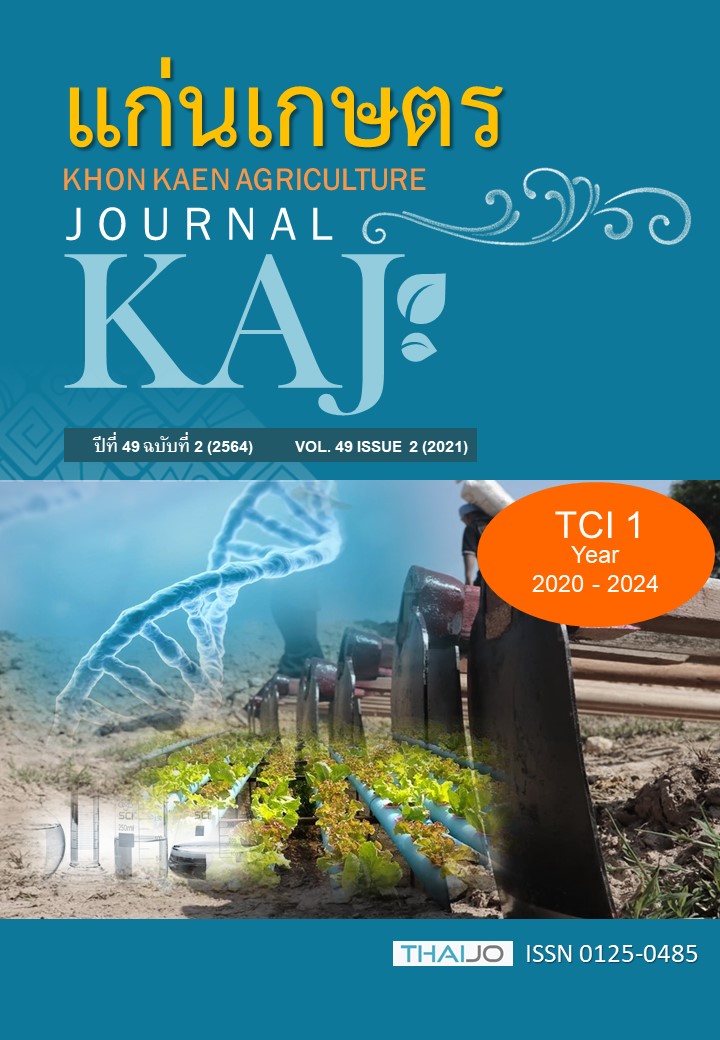Assessment of total phenolic and flavonoid contents, antioxidant activity, and anti-acetylcholinesterase activity from Codiaeum variegatum (L.) Blume leaves found in Thailand
Main Article Content
บทคัดย่อ
Codiaeum variegatum (L.) Blume contained many cultivars with different leaf shapes and coloration. Most cultivars of C. variegatum were widely used as vegetables in northern Thailand, in which two cultivars (spirale and broad leaf) were selected for the investigation of the phytochemical profiling and the biological activity related to the prevention of Alzheimer’s disease (AD). The ethanolic extracts of spirale and broad cultivars of C. variegatum (ESC and EBC) contained total phenolic content about 17.99±0.02 and 30.35±0.10 mg GAE/g extract, respectively. Total flavonoid content of the ESC and EBC were 39.30±0.20 and 34.72±0.67 mg QE/g extract, respectively. Quantitative estimation revealed that flavonoids, alkaloids, steroids, terpenoids, and cardiac glycosides are presented in both ESC and EBC. Both ESC and EBC showed weak scavenging activity against 2,2-diphenyl-l-picrylhydrazyl (DPPH) with IC50 values of 8.00±0.60 and 6.88±0.40 mg/mL, respectively. This study was considered the first report on the anti-acetylcholinesterase activity of C. variegatum leaves extracts. The microplate assay revealed that the spirale cultivar exhibited potent AChE inhibition with an IC50 value of 551.36 µg/mL while broad cultivar was inactive. Active compounds of spirale cultivar were supposed to be further investigated
Article Details

อนุญาตภายใต้เงื่อนไข Creative Commons Attribution-NonCommercial-NoDerivatives 4.0 International License.
เอกสารอ้างอิง
Anim, M. T., C. Larbie, R. Appiah-Opong, I. Tuffour, KB-A. Owusu, and A. Aning. 2016. Extracts of Codiaeum variegatum (L.) A. Juss is cytotoxic on human leukemic, beast and prostate cancer cell lines. Journal Applied Pharmaceutical Science. 6: 87-93.
Awoyinka, O. A., C. N. Ezekiel, E. B. Esan, C. G. Afolabi, O. Z. Ikokide, A. Bankole et al. 2012. The spectrum of infections by fusarium species on Codiaeum variegatum (L.) Blume cultivars as influenced by fructose specific lectin. International Journal of Modern Botany. 2: 145-153.
Bijekar, S., and M. C. Gayatri. 2015. Phytochemical profile of Codiaeum variegatum (L.) Bl. International Journal of Pharmacology and Pharmaceutical Science. 2: 22-31.
Ellman, G. L., K. D. Courtney, V. Andres, and R. M. Featherstone. 1961. A new and rapid colorimetric determination of acetylcholinesterase activity. Biochemical Pharmacology. 7: 88-90.
Larson, E. C., L. B. Hathaway, J. G. Lamb, C. D. Pond, P. P. Rai, T. K. Matainaho, P. Piskaut, L. R. Barrows, and M. R. Franklin. 2014.
Interactions of Papua New Guinea medicinal plant extracts with antiretroviral therapy. Journal of Ethnopharmacology. 155: 1433-1440.
Lomarat, P., K. Sripha, P. Phanthong, W. Kitphati, K. Thirapanmethee, and N. Bunyapraphatsara. 2015. In vitro biological activities of black pepper essential oil and its major components relevant to the prevention of Alzheimer’s disease. The Thai Journal of Pharmceutical Science. 39: 94-101.
Mollick, A. S., H. Shimoji, T. Denda, M. Yokota, and H. Yamasaki. 2011. Croton Codiaeum variegatum (L.) Blume cultivars characterized by leaf phenotypic parameters. Scienta Horticulturae. 132: 71-79.
Njoya, E. M., C. Weber, N. A. Hernandez-Cuevas, C-C. Hon, Y. Janin, M. F. G. Kamini, P. F. Moundipa, and N. Guillén. 2014. Bioassay-guided fractionation of extracts from Codiaeum variegatum against Entamoeba histolytica discovers compounds that modify expression of ceramide biosynthesis related genes. PLoS. Neglected Tropical Diseases. 8: 2607.
Ogunwenmo, K. O., O. A. Idowu, C. Innocent, E. B. Esan, and O. A. Oyelana. 2007. Cultivars of Codiaeum variegatum (L.) Blume (Euphorbiaceae) show variability in phytochemical and cytological characteristics. African Journal of Biotechnology. 6: 2400-2405.
Parke, D. V. 1999. Nutritional antioxidants and disease prevention: mechanism of action. In Antioxidants in human health and disease. Busa TK, Temple NJ, Garg ML. (Eds). CABI-publishing, London, UK.
Phanthong, P., N. P. Morales, S. Chancharunee, S. Mangmool, S. Anantachoke, and N. Bunyapraphatsara. 2015. Biological activity of Dolichandrone serrulata Flowers and their active components. Natural Product Communications. 10: 1387-1390.
Pharmacy CMU. 2020. Codiaeum variegatum (L.) Rumph. ex A.Juss. Available: https://www.pharmacy.cmu.ac.th/makok.php?id=171. Accessed Jan 8, 2020.
Rahman, M., A. Tajmim, M. Ali, and M. Sharif. 2017. Overview and current status of alzheimer’s disease in Bangladesh. Journal of Alzheimer’s Disease Reports. 1: 27-42.
Rio, D. D., A. Rodriguez-Mateos, J. P. E. Spencer, M. Tognolini, G. Borges, and A. Crozie. 2013. Dietary (poly) phenolics in human health: structures, bioavailability, and evidence of potective effects against chronic diseases. Antioxidants & Redox Signaling. 18: 1818-1892.
Saffoon, N., M. A. Alam, and G. M. Uddin. 2010. Phytochemical and cytotoxic investigation of Codiaeum variegatum Linn. leaf. Stamford Journal of Pharmaceutical Sciences. 3: 51-53.
Saffoon, N., R. Uddin, N. Subhan, H. Hossain, H. Reza, and M. A. Alam. 2014. In vitro anti-oxidant activity and HPLC-DAD system based phenolic content analysis of Codiaeum variegatum found in Bangladesh. Advanced Pharmaceutical Bulletin. 4: 533-541.
Sankhalkar, S., and V. Vernekar. 2016. Quantitative and qualitative analysis of phenolic and flavonoid content in Moringa oleifera Lam and Ocimum tenuiflorum L. Pharmacognosy Research. 8: 16-21.
Tsao, R. 2010. Chemistry and biochemistry of dietary polyphenols. Nutrients. 2: 1231-1246.


